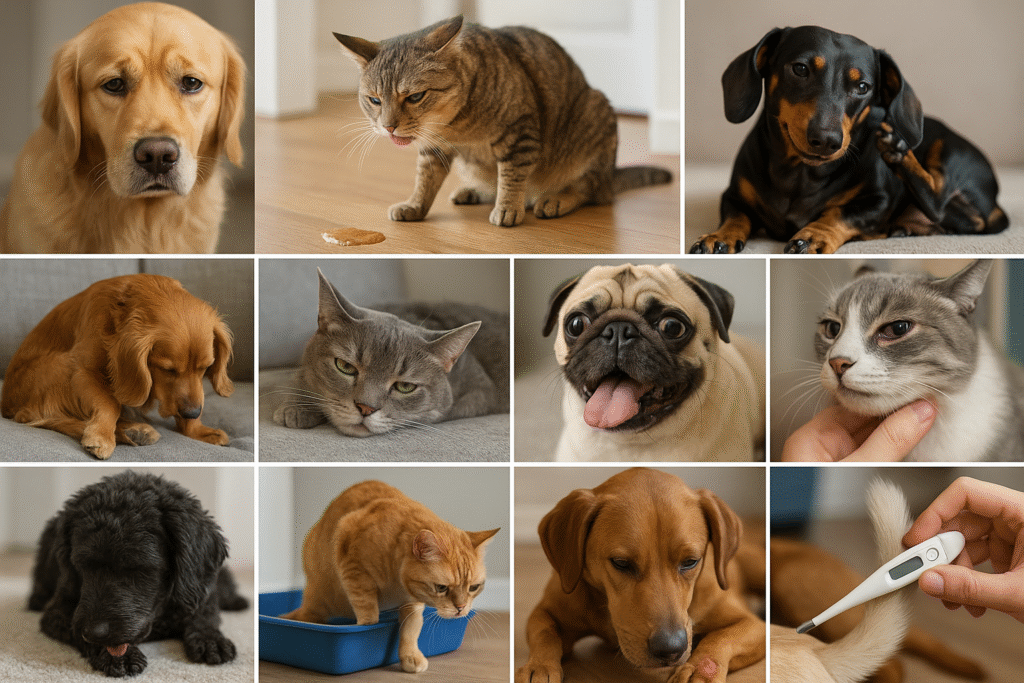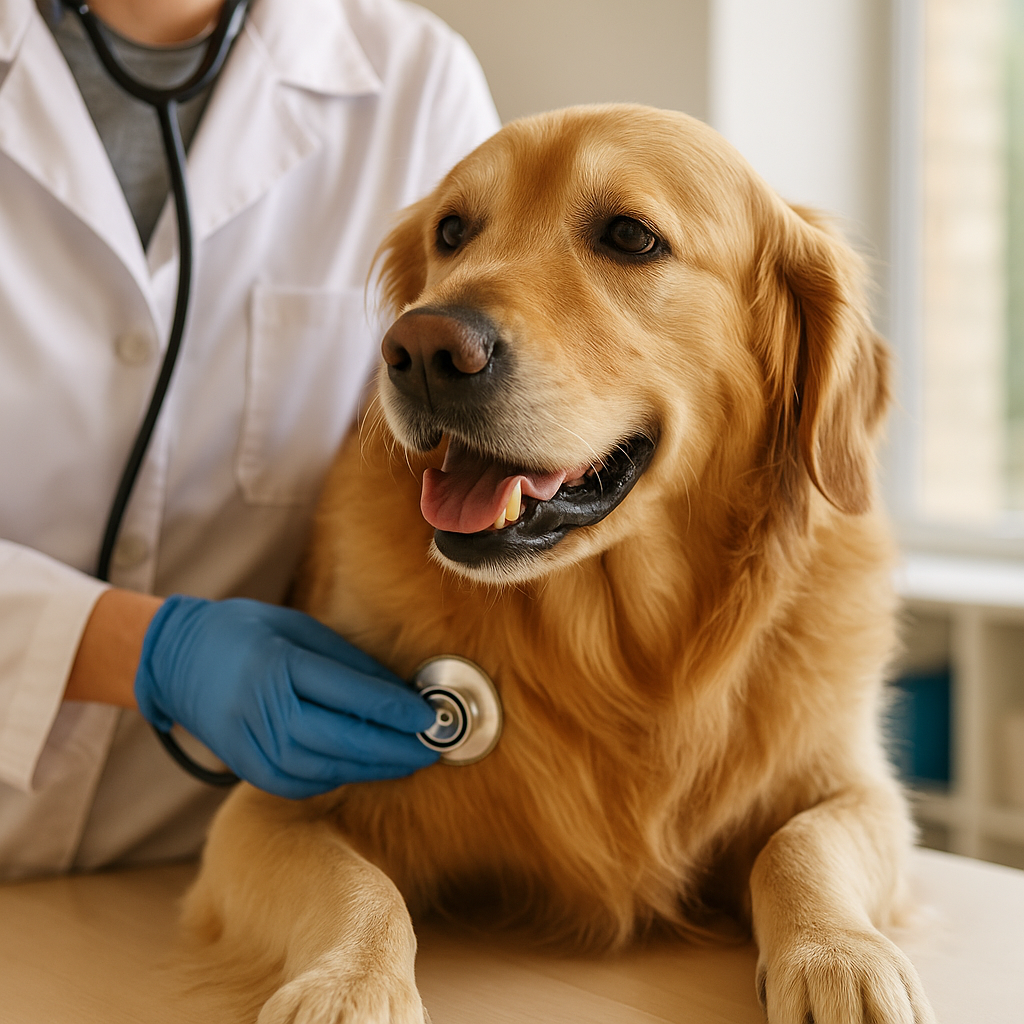Knowing when is it time to see the vet can feel like walking a tightrope: ignore a subtle sign and things could get worse; rush in for every sniffle and you’ll wear out your wallet and your patience. This guide helps you read the signals—urgent vs. urgent-but-not-emergency vs. routine—so you can act confidently. It’s written for pet parents in the United States, the United Kingdom, and worldwide, with country-specific resources, step-by-step checklists, DIY first-aid tips, and printable action plans.
Quick overview: how to use this guide
- Scan the Red Flags (emergency signs) — these require immediate vet care.
- Read the Urgent but Not ‘Call 911’ signals — call your vet or emergency clinic within hours.
- Learn the Watch & Record signs — monitor for 24–48 hours and call if they stay or worsen.
- Prepare a small Vet-Ready Kit and a plan for your country (US or UK) so you can act fast.
When in doubt, call your vet for advice — they’d rather guide you than have you guess. Public health authorities and veterinary bodies emphasize contacting a veterinarian whenever you suspect illness. (CDC)
Section A — Red Flags: go to emergency care now
If your pet shows any of the following, this is a medical emergency. Transport them (safely restrained) to an emergency clinic or call your vet and tell them you’re on the way.
- Difficulty breathing, choking, or persistent coughing. Breathing issues can escalate quickly. (AVMA)
- Uncontrolled bleeding (not stopping after 3–5 minutes of pressure). (AVMA)
- Seizure(s) lasting >2–5 minutes, or repeated seizures in 24 hours. Time the seizure and call the clinic immediately. (AVMA)
- Inability to urinate (cats) — especially male cats — this can be life-threatening. (AVMA)
- Ingestion of a known poison (antifreeze, xylitol, large amounts of medication). Call your poison line and your vet immediately. (Pet Poison Helpline, ASPCA)
- Collapse, loss of consciousness, or sudden severe weakness. (AVMA)
- Severe trauma (hit by car, fall from height, deep wounds). (AVMA)
If you’re in the US, emergency hospital networks and 24/7 poison hotlines (ASPCA APCC, Pet Poison Helpline) are available for immediate guidance. If you’re in the UK, contact your regular practice and—if closed—use a listed emergency clinic or call services recommended by RCVS or RSPCA. (ASPCA, Pet Poison Helpline, Find A Vet)

Section B — Urgent (call your vet within a few hours)
These signs are serious and need veterinary advice within hours — you don’t always need to rush to emergency, but you should call and follow instructions.
- Persistent vomiting or diarrhoea (especially with blood or causing dehydration).
- Refusal to eat for 48 hours (24 hours for very young or ill pets).
- House-soiling or straining to urinate (may indicate urinary obstruction or infection).
- Sudden lameness, inability to bear weight, or obvious bone deformity (may need X-rays/splint).
- Sudden change in behavior (aggression, hiding, confusion) particularly in older pets — cognitive issues or metabolic problems can show as behavior changes. (PDSA, AVMA)
What to do: keep the animal calm, offer small amounts of water, and call the vet with exact symptom onset, any known exposures, and the pet’s weight. These details help triage. (CDC)
Section C — Watch & Record (monitor for 24–48 hours)
Some mild signs can be observed at home if your pet is otherwise bright and eating small amounts.
- Sneezing, mild nasal discharge (unless breathing is difficult).
- Single episode of vomiting with no other signs — monitor appetite, energy, and stool.
- Mild limp that improves with rest — still call if it persists or worsens.
- Slight decrease in appetite or low energy for less than 48 hours — keep notes.
Keep a short log: time, symptom, food/drink intake, stool/urine appearance, and any exposure (new food, medication, plants). If anything worsens, call your vet. The PDSA symptom checker is a useful UK resource for deciding when to escalate. (PDSA)
Section D — Subtle signs you must not ignore (pets hide illness)
Pets are masters at disguising pain. Watch for these subtle but important hints:
- Loss of appetite or interest in favourite toys/treats — often the earliest sign.
- Change in bathroom habits (more frequent/less frequent, straining, blood).
- Hiding, reduced grooming, or overgrooming (cats may stop using the litter box).
- Small changes in mobility: hesitating to jump, slower on stairs.
- Unusual thirst or increased urination — can signal endocrine or kidney disease. (PDSA, AVMA)
If you spot any of these, jot them down and call your vet for advice — early diagnosis is usually simpler and cheaper.
Section E — Country differences: US vs UK (how to get help fast)
United States — practical steps
- Primary care vets operate regular hours; many areas have 24/7 emergency hospitals (search for “VCA Emergency, BluePearl, or local 24-hour vet” in your area).
- ASPCA Animal Poison Control Center (APCC) is available 24/7 at (888) 426-4435 for toxic exposures (consultation fee applies). Use it if you suspect poisoning. (ASPCA)
- Pet Poison Helpline (another 24/7 option) also offers guidance — keep their number saved. (Pet Poison Helpline)
- Keep your vet’s after-hours instructions and the nearest emergency hospital posted on the fridge.
United Kingdom — practical steps
- Register with an RCVS-registered practice and note their emergency protocol; if you need a vet quickly, RCVS’ “Find a Vet” service helps locate local accredited practices and emergency clinics. (Find A Vet)
- UK charities such as PDSA and RSPCA offer symptom checkers and emergency advice; some have low-cost options and guidance on when to seek urgent care. (PDSA, RSPCA)
- If you can’t reach your own vet, call a recommended 24-hour clinic or use RCVS resources for out-of-hours help. (Find A Vet)
Section F — Step-by-step what to do when your pet is sick
- Stay calm & assess — Is the pet breathing? Conscious? Bleeding heavily? (If yes, head to emergency.)
- Remove hazards — If you suspect poisoning, remove access to the substance and lock the area. Save packaging or labels. (Pet Poison Helpline)
- Call your vet — Give: pet’s species, age, weight, brief history, symptoms, time of onset, and any known exposures.
- Follow triage instructions — Your vet may advise home care, urgent drop-off, or emergency hospital transfer.
- Transport safely — Use a carrier for cats or small dogs; muzzle only if necessary and safe; carry a towel/blanket for support.
- Bring documentation — vaccination records (if available), a list of medications, and the packaging of anything ingested.
- Record everything — time of symptom onset and any treatment given (including home remedies). This helps the vet make fast, accurate decisions.
Section G — DIY first-aid kit for pet parents (assemble now)
Keep this compact kit near your exits:
- Leash, harness, towel/blanket, and carrier
- Flashlight, digital thermometer (rectal for pets), and disposable gloves
- Gauze, non-stick bandage pads, vet wrap or self-adhesive bandage
- Antiseptic wipes (pet-safe), small scissors, tweezers
- Emergency contact list: your vet, nearest emergency clinic, ASPCA APCC, Pet Poison Helpline, and local animal control numbers (US) or RSPCA/PDSA (UK)
- Copies of medical records or at least summary notes with current meds and allergies
Having this ready saves minutes — and minutes can save lives.

Section H — When your vet says “watch at home” — what that means
If your vet tells you to monitor, they’ll usually ask you to watch for specific trigger signs and check them every few hours (temperature, appetite, vomiting frequency, energy). Keep a log and return to the clinic or emergency hospital if the trigger signs occur.
Example: “If vomiting continues more than 6 times in 12 hours, or if the pet becomes lethargic, come in immediately.” Write that instruction down and set a phone alarm.
Section I — Finding and choosing emergency care (how to pick fast)
- US: Look for 24/7 hospitals that list board-certified specialists or affiliations (BluePearl, VCA, university hospitals). For poisons, call ASPCA APCC (888-426-4435) or Pet Poison Helpline first if needed. (ASPCA, Pet Poison Helpline)
- UK: Use RCVS Find a Vet to locate accredited practices and emergency clinics near you. Confirm opening hours, out-of-hours arrangements, and whether they accept walk-ins. (Find A Vet)
Pro tip: Save the Google Maps link for the fastest route and have an emergency payment plan in place (care credit, savings, or pet insurance details).
Section J — Preventive steps to reduce vet visits
- Keep up routine vaccinations, parasite prevention, dental care, and weight checks. Preventive care reduces many emergencies. (AVMA)
- Pet-proof your home: secure chemicals, medicines, and small objects. Keep toxic foods out of reach.
- Microchip your pet and keep contact details updated — this speeds up reunification and helps vets find records. (AVMA)
Printable Quick Checklist (copy/print for fridge)
Emergency now (go to ER):
- Difficulty breathing / collapse / seizures / uncontrolled bleeding / cannot urinate (cat) / poisoning
Call vet within hours:
- Persistent vomiting/diarrhea, refusal to eat >24–48 hr, limping that worsens, sudden behavior changes
Watch & record for 24–48 hr:
- Mild sneezing, one-off vomiting, slight appetite dip (note time + details)
Always bring:
- Photo ID of pet, weight, meds, packaging of ingested items, emergency contact numbers
Official Resources & Hotlines (clickable)
- AVMA — 13 animal emergencies that require immediate care. (Emergency signs & first aid). (AVMA)
https://www.avma.org/resources/pet-owners/emergencycare/13-animal-emergencies-require-immediate-veterinary-consultation-andor-care - CDC — Healthy Pets, Healthy People (general guidance: contact a veterinarian if you suspect illness). (CDC)
https://www.cdc.gov/healthy-pets/ - ASPCA Animal Poison Control Center (APCC) — 24/7 poison hotline: (888) 426-4435. (ASPCA)
https://www.aspca.org/pet-care/aspca-poison-control - Pet Poison Helpline — 24/7 animal poison control service (phone & web resources). (Pet Poison Helpline)
https://www.petpoisonhelpline.com/ - RCVS — Find a Vet (UK) — search accredited vets and emergency clinics. (Find A Vet)
https://findavet.rcvs.org.uk/home/ - PDSA — Pet symptom checker & vet care guidance (UK). (PDSA)
https://www.pdsa.org.uk/pet-help-and-advice/looking-after-your-pet/all-pets/how-do-vets-diagnose-pets
Final thoughts — trust your gut, then verify
Asking “when is it time to see the vet?” is a common worry. The short answer: trust your instincts—if something feels off, call and describe it. Veterinarians are used to triaging over the phone and will tell you whether to watch, bring the pet in, or go to emergency. Early action often means simpler treatment and better outcomes.
Disclaimer: This post is educational and does not replace professional veterinary care. If you suspect your pet is in immediate danger, contact your local emergency veterinary clinic right away. For poisoning incidents, call your local animal poison control center (US: ASPCA APCC at (888) 426-4435; Pet Poison Helpline; UK: contact your vet or RSPCA/PDSA guidance services). (ASPCA, Pet Poison Helpline, PDSA). All images used in this article are royalty‑free or licensed for commercial use and are provided here for illustrative purposes.
